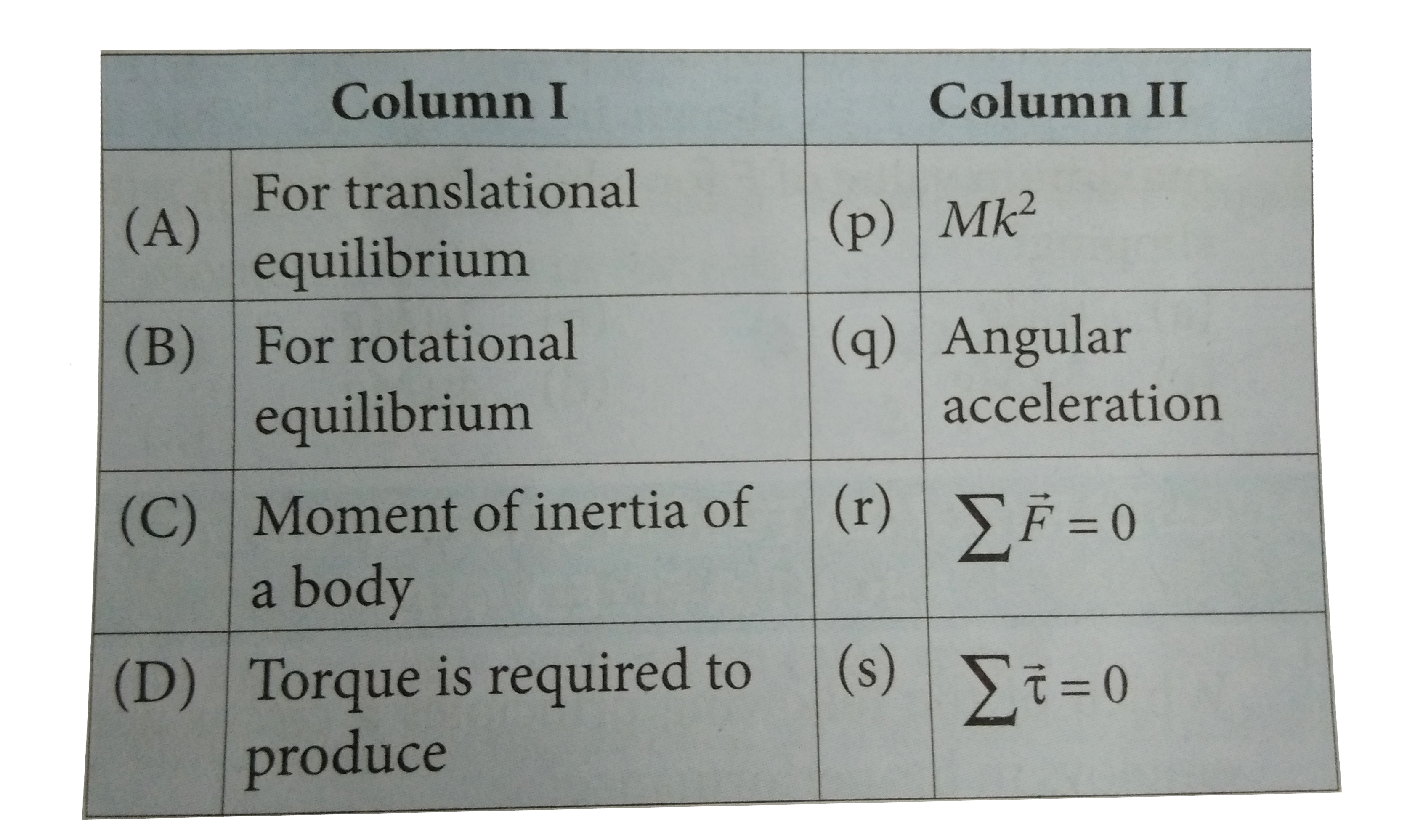Match the columns :
Column IColumn II(1)Polluting energy(a)Soot particles(2)Eco-friendly energy(b)Thermal energy(c)Nuclear energy(c)Wind energy
To solve the matching question, we need to identify which items from Column I correspond to the items in Column II based on the characteristics of the energy types mentioned.
1. Identify Polluting Energy:
- From Column I, we have "Polluting energy".
- We need to find which energy types from Column II are considered polluting.
2. Analyze Thermal Energy:
- Thermal energy is produced by burning fossil fuels.
- The combustion process can release pollutants like carbon dioxide, carbon monoxide, and soot particles.
- Therefore, thermal energy is a polluting energy.
3. Analyze Nuclear Energy:
- Nuclear energy produces radioactive waste, which is hazardous and difficult to dispose of.
- The presence of radioactive materials makes nuclear energy polluting as well.
4. Identify Eco-friendly Energy:
- The remaining energy types in Column II are "Wind energy" and "Soot particles".
- Soot particles are not a type of energy; they are a pollutant resulting from the burning of fossil fuels.
- Wind energy is clean and does not produce harmful emissions or waste, making it eco-friendly.
5. Match the Columns:
- From the analysis:
- Polluting energy:
- (1) Thermal energy → (b) Thermal energy
- (2) Nuclear energy → (c) Nuclear energy
- Eco-friendly energy:
- Wind energy → (c) Wind energy
Final Matching:
- (1) Polluting energy → (b) Thermal energy
- (2) Eco-friendly energy → (c) Wind energy
- From Column I, we have "Polluting energy".
- We need to find which energy types from Column II are considered polluting.
- Thermal energy is produced by burning fossil fuels.
- The combustion process can release pollutants like carbon dioxide, carbon monoxide, and soot particles.
- Therefore, thermal energy is a polluting energy.
- Nuclear energy produces radioactive waste, which is hazardous and difficult to dispose of.
- The presence of radioactive materials makes nuclear energy polluting as well.
- The remaining energy types in Column II are "Wind energy" and "Soot particles".
- Soot particles are not a type of energy; they are a pollutant resulting from the burning of fossil fuels.
- Wind energy is clean and does not produce harmful emissions or waste, making it eco-friendly.
- From the analysis:
- Polluting energy:
- (1) Thermal energy → (b) Thermal energy
- (2) Nuclear energy → (c) Nuclear energy
- Eco-friendly energy:
- Wind energy → (c) Wind energy
- (1) Polluting energy → (b) Thermal energy
- (2) Eco-friendly energy → (c) Wind energy
Topper's Solved these Questions
- MODEL ACTIVITY SHEET Book:NAVNEET PUBLICATION - MAHARASHTRA BOARDChapter:MODEL ACTIVITY SHEET Exercise:ANSWER THE FOLLOWING
Explore 5 Videos
- MODEL ACTIVITY SHEET Book:NAVNEET PUBLICATION - MAHARASHTRA BOARDChapter:MODEL ACTIVITY SHEET Exercise:ANSWER THE FOLLOWING
Explore 5 Videos
- MISCELLANEOUS QUESTIONS Book:NAVNEET PUBLICATION - MAHARASHTRA BOARDChapter:MISCELLANEOUS QUESTIONS Exercise:Assignment
Explore 2 Videos
- MODEL ACTIVITY SHEET FOR PRACTICEBook:NAVNEET PUBLICATION - MAHARASHTRA BOARDChapter:MODEL ACTIVITY SHEET FOR PRACTICEExercise:Exercise
Explore 18 Videos
Similar Questions
Column IColumn II(a)Work(p)WF(b)Kinetic energy(q)mgh(c)Potential energy(r)12mv2(d)Displacement(s)F×S
View SolutionMatch the following :
Column-1 Column-2(A)Electrostatic potential energy(P) Positive(B)Gravitational potential energy(Q) Negative(C)Elastic potential energy(R) Zero(D)Magnetic potential energy(S) Not defined
View Solution
Knowledge Check
Match the Column I and Column II.,B
 AA-p, B-q, C-r, D-sBA-q, B-r, C-s. D-pCA-r, B-q, C-p, D-pDA-r, B-s, C-p, D-q
AA-p, B-q, C-r, D-sBA-q, B-r, C-s. D-pCA-r, B-q, C-p, D-pDA-r, B-s, C-p, D-qMatch item in column I with those given in column II. Column 1
 AA-V, B-IV, C-III, D-I, E-IIBA-IV, B-V, C-II, D-I, E-IICA-IV, B-V, C-III, D-II, E-IDA-V, B-III, C-I, D-II, E-IV
AA-V, B-IV, C-III, D-I, E-IIBA-IV, B-V, C-II, D-I, E-IICA-IV, B-V, C-III, D-II, E-IDA-V, B-III, C-I, D-II, E-IVMatch the following columns. (for a satellite in circular orbit)
Column-IColumn-II(A)Kinetic energy(p)−GMm2r(B)Potential energy(q)√GMr(C)Total energy(r)−GMmr(D)Orbital speed(s)GMm2rA(A→s,B→r,C→p,D→q)B(A→c,B→s,C→p,D→q)C(A→s,B→r,C→q,D→p)D(A→q,B→r,C→p,D→s)
Match the terms in column I with those in column II:
Column IColumn II(i)Trypsin(a)Liver(ii)Amylase(b)Gastric glands(iii)Bile(c)Pancreas(iv)Pepsin(d)Saliva
View SolutionColumn IColumn II(A)Stress(p)Pressure(B)Strain(q)Energy density(C)Modulus of elasticity(r)Angle(D)Torque(s)Energy
View SolutionMatch the statements in Column I labeled as (a), (b), (c ), and (d) with those in Column II labeled as (p), (q), (r ), and (s). Any given statement in Column I can have correct matching with one or more statements in Column II.
An electron in hydrogen atom moves from n=1 to n=2.
Column IColumn II(a) Angular momentum(p) One-forth times(b) Kinetic energy(q) Two times(c) Potential energy(r) Four times(d) Mechanical energy(s) Half times
View SolutionMatch the following
Column-IColumn-II(A)Enthalpy(p)Extensive property(B)Entropy(q)H - TS(C)Free energy(r)E + PV(D)Pressure(s)Intensive property
View SolutionMatch column - I with column -II
Column -IColumn -II(a)Gravitational force(p)Central(b)Viscous force(q) Non-conservative(c)Electric force(r) Conservative(d)Friction(s) Mechanical energy is conserved
View Solution
